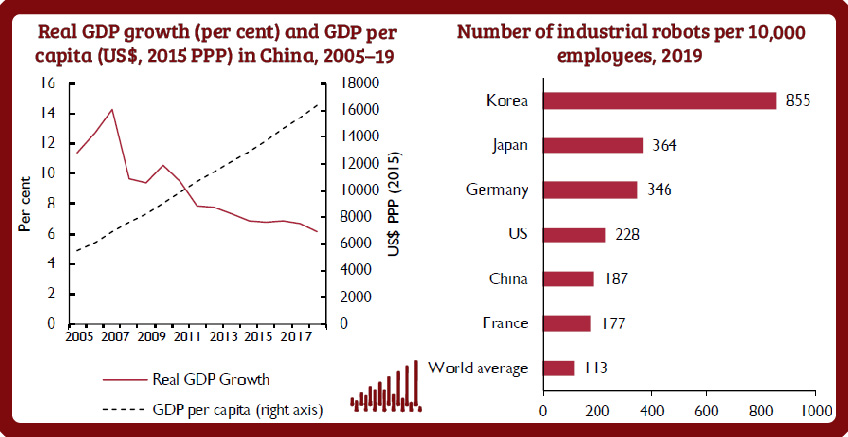- Home
- Publications
- Growth, Productivity And Digitalisation In China
Growth, Productivity and Digitalisation in China
 Pub. Date
Pub. Date
 Pub. Type
Pub. Type

This is a preview from the National Institute Economic Review, November 2020, no 254.
Despite so far successfully bouncing back after Covid-19 shock, China is facing a twin challenge from falling global demand and its rapidly ageing society. To address this challenge, the country needs to raise domestic labour productivity by embracing wide adoption and diffusion of digital technologies and automation. There is a saying that ‘China is growing old before it’s getting rich’. In fact, due to low birth rates and rising life expectancy the UN projects that in 80 years China’s population will shrink from 1.4 to less than 1.1 billion people. At the same time GDP per capita is still 3-4 times below the US, Germany and UK. China’s export-led growth model is vulnerable to falling demand for its exports, and at the same time Chinese overseas expansion via multinational enterprises also faces increasing challenges due to national security concerns.
NIESR Senior Economist David Nguyen, who has prepared the analysis in this Box, said: "Although China has a competitive edge in digital economy, it has to face important challenges in order to achieve higher productivity levels based on wider adoption and diffusion of digital technologies with an ageing population in a post-pandemic world. Moreover, there is a downside risk to growth if China decides to respond to Western protectionism regarding its digital companies with further protectionist measures at home."
Related Blog Posts

Exploring the Data on UK Productivity Performance
Issam Samiri
Stephen Millard
11 Dec 2023
4 min read

UK Investment Past and Prospects: A Framework for Analysis
Catherine Mann
01 Dec 2023
6 min read


Where Are We With Regional Inequalities in the UK?
Adrian Pabst
Jagjit S. Chadha
01 Nov 2023
5 min read
Related Projects
Related News


Related Publications


Productivity and Investment: Time to Manage the Project of Renewal
12 Mar 2024
UK Productivity Commission

UK Households Should Start Feeling Better Off as Election Looms
07 Feb 2024
UK Economic Outlook

The Financial (In)Stability Real Interest Rate, R**, as a Monetary Policy Constraint
07 Feb 2024
Global Economic Outlook Box Analysis
Related events

Investing for Growth: boosting productivity through higher public and private investment

The Outlook for the Welsh Economy

Prais Lecture with Chris Pissarides: The Future of Work and Wellbeing

A View and Prospects for British Investment

How Can We Raise Investment?

Productivity Commission Evidence Session: Examining the Role of International Investment

High Dimensional Forecasting and its Pitfalls – M. Hashem Pesaran

Finance and Growth Workshop







